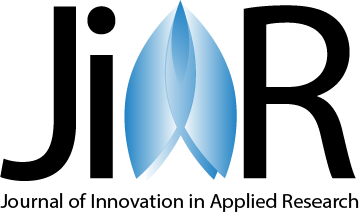
Phytochemical Profiling of Phyllanthus emblica Leaf Extract
5
Views
41
Downloads
Phyllanthus emblica is one of the most important plants in the traditional Indian system of medicine with wide range of pharmacological and nutritional applications even in present day therapeutics. In the present investigation identification of different bioactive components present in Phyllanthus emblica has done by performing various phytochemical test. For this the methanolic extract of leaves of Phyllanthus emblica has been prepared by Soxhlet extraction method. The presence of different bioactive component i.e., carbohydrate, protein, alkaloid, Triterpenoids and Steroids, Saponins, etc. has determined by performing different qualitative test i.e., Mayer, Molish, Ninhydrin foam test etc. The positive result of different qualitative test indicates the presence of alkaloids, carbohydrate, reducing sugar and steroids whereas negative results indicate the absence of saponin and proteins.
Phyllanthus emblica is one of the most important plants in the traditional Indian system of medicine with wide range of pharmacological and nutritional applications even in present day therapeutics. In the present investigation identification of different bioactive components present in Phyllanthus emblica has done by performing various phytochemical test. For this the methanolic extract of leaves of Phyllanthus emblica has been prepared by Soxhlet extraction method. The presence of different bioactive component i.e., carbohydrate, protein, alkaloid, Triterpenoids and Steroids, Saponins, etc. has determined by performing different qualitative test i.e., Mayer, Molish, Ninhydrin foam test etc. The positive result of different qualitative test indicates the presence of alkaloids, carbohydrate, reducing sugar and steroids whereas negative results indicate the absence of saponin and proteins.
<?xml version="1.0" encoding="UTF-8" standalone="yes"?>
<!DOCTYPE article PUBLIC "-//NLM//DTD JATS (Z39.96) Journal Publishing DTD v1.2d1 20170631//EN" "JATS-journalpublishing1.dtd">
<article xlink="http://www.w3.org/1999/xlink" dtd-version="1.0" article-type="plant-biotechnology" lang="en">
<front>
<journal-meta>
<journal-id journal-id-type="publisher">JIAR</journal-id>
<journal-id journal-id-type="nlm-ta">Journ of innovation in applied research</journal-id>
<journal-title-group>
<journal-title>Journal of Innovation in Applied Research</journal-title>
<abbrev-journal-title abbrev-type="pubmed">Journ of innovation in applied research</abbrev-journal-title>
</journal-title-group>
<issn pub-type="ppub">2231-2196</issn>
<issn pub-type="opub">0975-5241</issn>
<publisher>
<publisher-name>Radiance Research Academy</publisher-name>
</publisher>
</journal-meta>
<article-meta>
<article-id pub-id-type="publisher-id">46</article-id>
<article-id pub-id-type="doi">10.51323/JIAR.4.1.2021.17-22</article-id>
<article-id pub-id-type="doi-url"/>
<article-categories>
<subj-group subj-group-type="heading">
<subject>Plant Biotechnology</subject>
</subj-group>
</article-categories>
<title-group>
<article-title>Phytochemical Profiling of Phyllanthus emblica Leaf Extract
</article-title>
</title-group>
<contrib-group>
<contrib contrib-type="author">
<name>
<surname>Dubey</surname>
<given-names>Shashi Kumar</given-names>
</name>
</contrib>
<contrib contrib-type="author">
<name>
<surname>Mishra</surname>
<given-names>Deepak</given-names>
</name>
</contrib>
</contrib-group>
<pub-date pub-type="ppub">
<day>1</day>
<month>01</month>
<year>1970</year>
</pub-date>
<volume>4</volume>
<issue/>
<fpage>17</fpage>
<lpage>22</lpage>
<permissions>
<license license-type="open-access" href="http://creativecommons.org/licenses/by/4.0/">
<license-p>This is an open-access article distributed under the terms of the Creative Commons Attribution (CC BY 4.0) Licence. You may share and adapt the material, but must give appropriate credit to the source, provide a link to the licence, and indicate if changes were made.</license-p>
</license>
</permissions>
<abstract>
<p>Phyllanthus emblica is one of the most important plants in the traditional Indian system of medicine with wide range of pharmacological and nutritional applications even in present day therapeutics. In the present investigation identification of different bioactive components present in Phyllanthus emblica has done by performing various phytochemical test. For this the methanolic extract of leaves of Phyllanthus emblica has been prepared by Soxhlet extraction method. The presence of different bioactive component i.e., carbohydrate, protein, alkaloid, Triterpenoids and Steroids, Saponins, etc. has determined by performing different qualitative test i.e., Mayer, Molish, Ninhydrin foam test etc. The positive result of different qualitative test indicates the presence of alkaloids, carbohydrate, reducing sugar and steroids whereas negative results indicate the absence of saponin and proteins.
</p>
</abstract>
<kwd-group>
<kwd>Phyllanthus emblica</kwd>
<kwd>phytochemical analysis</kwd>
<kwd>leaf extract</kwd>
</kwd-group>
</article-meta>
</front>
</article>